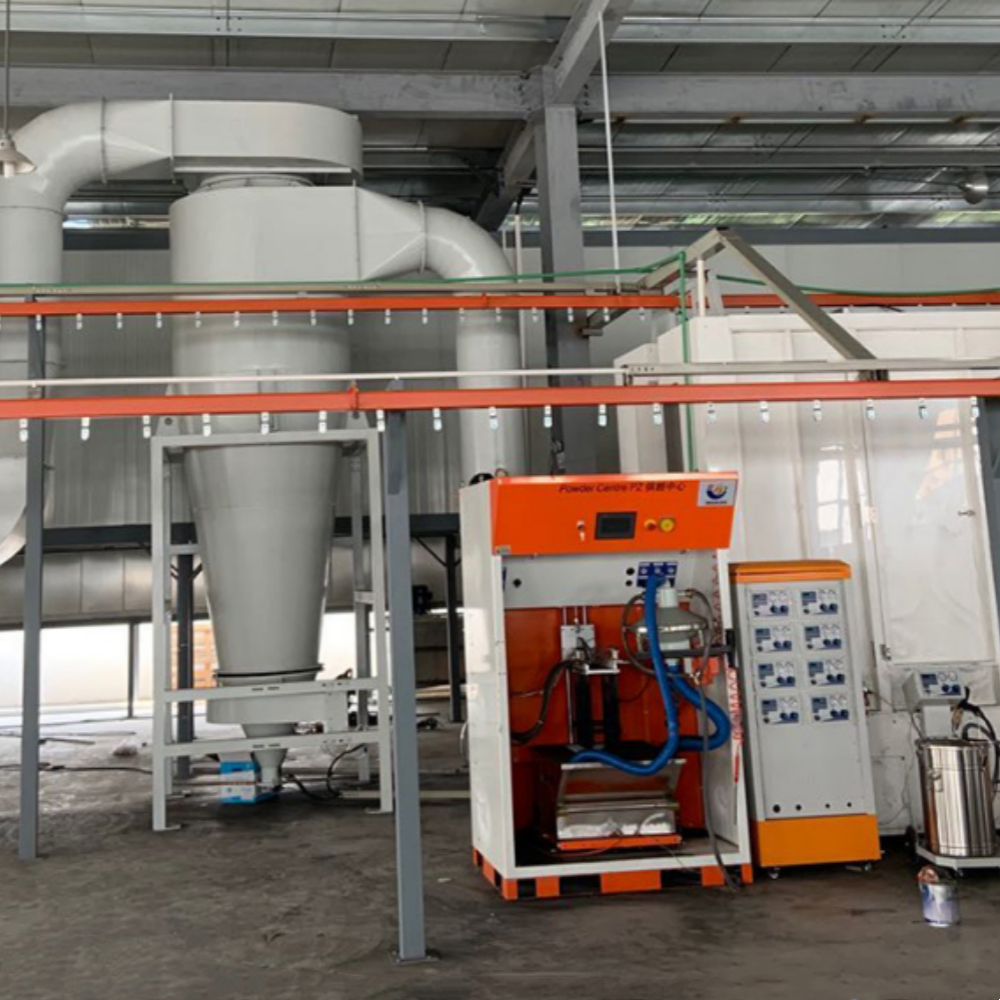Understanding Fire Hazards in the Powder Coating Booth Environment
Why Powder Coating Booths Are Prone to Fires
Powder coating booths are inherently susceptible to fires due to the combination of combustible dust and electrical equipment. Airborne overspray can ignite when exposed to static discharges or overheating components. A 2023 industrial safety study found that 67% of booth fires originate from malfunctioning curing ovens, ungrounded equipment, and inadequate ventilation.
Combustible Dust and Ignition Sources: The Core Risks
The primary danger stems from the interaction between accumulated overspray and potential ignition sources:
- Static electricity from improperly grounded racks or conveyors
- Sparks from non-explosion-proof motors or lighting
- Heat buildup in curing zones exceeding powder autoignition temperatures (typically 400–500°C)
Even a small concentration—one gram of powder per cubic meter—can create an explosive atmosphere, equivalent to 4 lbs of residue in a standard booth.
Case Study: Fire Incident Caused by Poor Grounding in a Midwestern Facility
In 2022, a metal fabrication plant suffered a $2.3M fire loss triggered by static sparks from ungrounded conveyor rollers. Investigators identified critical failures:
|
Factor |
Detail |
Consequence |
|
Grounding |
14/20 racks lacked proper bonding |
Sparks ignited dust layers |
|
Maintenance |
18-month filter replacement gap |
2" dust buildup on ductwork |
|
Response |
No automated suppression system |
23-minute fire department arrival delay |
The resulting 78-day production halt and OSHA penalties exceeded initial upgrade costs by 300%.
Rising Trends: Inadequate Explosion-Proof Equipment and Grounding Failures
Recent NFPA reports show a 41% increase in incidents linked to:
- Retrofitting electrical components that bypass Class II, Division 2 standards
- Using standard exhaust fans instead of spark-resistant models to cut costs
- Skipping grounding continuity checks during installation
Strategy: Eliminating Ignition Risks Through Proper Equipment Selection
Proactive facilities mitigate fire risks by:
- Selecting motors, lights, and controls with ATEX/IECEx certification
- Installing real-time grounding verification systems with audible alerts
- Opting for radial airflow booth designs, which reduce dust accumulation by 60% compared to crossdraft systems
When paired with strict maintenance, these measures can reduce fire-related downtime by up to 92% (Industrial Coating Journal, 2023).
Preventing Combustible Dust Accumulation with Overspray Containment and Booth Maintenance
Best Practices for Overspray Containment in the Powder Coating Booth
Effective containment begins with booth design and workflow efficiency. Smooth, nonporous interior surfaces minimize dust adhesion, while antistatic materials reduce static charges. Ensuring all conductive components are grounded and using explosion-proof ventilation prevents spark generation and lowers fire risk.
Effective Cleaning Protocols to Maintain a Safe Working Environment
Daily cleaning reduces combustible dust accumulation by 60–75% compared to weekly routines. Use HEPA-filtered vacuums for dry debris and non-sparking tools for wet removal. Focus on filters, exhaust ducts, and electrostatic gun components. Facilities with daily protocols report 84% fewer fire incidents (Industrial Safety Journal, 2023).
Innovation Spotlight: Self-Cleaning Booth Liners Reduce Fire Load
Advances in polymer technology now allow booth liners to release overspray during routine cleaning. These liners cut manual scrubbing time by 40% and significantly reduce residual powder buildup. Early adopters have seen a 52% drop in combustible dust-related safety violations.
Booth Inspection Checklist: Daily and Monthly Maintenance Routines
- Daily: Verify filter integrity, inspect grounding connections, check spray gun nozzles
- Monthly: Test emergency shutoffs, clean plenum chambers, audit electrical systems for NFPA 33 compliance
Digital Monitoring Tools for Tracking Booth Safety Improvements
IoT sensors monitor real-time dust concentration and airflow velocity, automatically alerting staff to deviations from OSHA exposure limits. Analyzing historical data enables predictive maintenance, reducing unplanned downtime by 31%. This integration of engineering controls, procedures, and technology creates a comprehensive safety strategy.
Optimizing Ventilation and Air Quality to Minimize Health and Fire Risks
Ventilation Standards for Safe Powder Coating Operations
Good ventilation matters a lot when it comes to keeping people safe from health problems and avoiding fire dangers. According to ASHRAE standard 62.1, buildings need at least 15 to 20 air changes every hour just to get rid of dangerous dust particles and those harmful volatile organic compounds properly. When systems don't hit these numbers, dust levels can climb past 45 grams per cubic meter, which is way over the 30 gram limit set by NFPA 33 for safe operation. Proper grounding of equipment that builds up static electricity plus installing fans designed to resist sparks goes a long way toward meeting what OSHA expects. Facilities that follow these practices tend to see around a 60 percent drop in potential ignition sources compared to ones that don't bother with compliance.
Airflow Design and Overspray Containment Efficiency
Smart airflow design stops hazardous dust buildup in workshops. Most effective systems use either crossdraft or downdraft setups where air moves at around half to one meter per second. This speed captures nearly all the overspray before it has a chance to land on surfaces. The difference between enclosed conveyors with HEPA filters and regular open face models is night and day. Tests show these sealed systems cut loose particles down by about three quarters. For maximum control, many facilities install angled baffles along with electrostatic pre-filters. These combinations keep dust concentrations below ten milligrams per cubic meter even when machines are running flat out during busy periods.
Data Insight: Facilities with Upgraded Ventilation Report 40% Fewer Respiratory Issues
In 2023 researchers looked at 200 different coating plants and discovered something interesting about ventilation upgrades following ASHRAE 62.1 standards. Worker complaints related to breathing problems dropped by around 40% after these improvements were made. Facilities that installed real time air quality monitoring systems managed to keep particulate levels under 5 mg per cubic meter, which is actually half what OSHA considers acceptable. Plus there was another benefit too - these sites experienced 33% fewer fires. So it seems clear that getting the airflow right not only helps protect workers' health but also keeps equipment safer from damage caused by poor ventilation conditions.
Implementing Fire Suppression Systems for Maximum Protection in Powder Coating Booths
Types and Effectiveness of Fire Suppression Systems in Spray Booths
Fire safety in modern booths needs special attention because different materials present unique hazards. Dry chemical extinguishers work by stopping the chemical reaction of flames, carbon dioxide systems put out fires by taking away oxygen which makes them great for tight spaces, and water mist technology both cools down hot surfaces and stops dust from spreading through the air. A recent study published in the Industrial Safety Review back in 2023 found something interesting: companies that combined methods like chemical suppression with water mist saw their fire related shutdowns drop by almost two thirds compared to those relying on just one type of system. This kind of hybrid approach seems to be gaining traction across industries concerned about both safety and operational continuity.
Integrating Suppression Systems with Booth Design and Ventilation
Integration should begin at the design stage. Explosion-proof ductwork and static-dissipative materials reduce ignition risks, while strategic ventilation ensures suppression agents reach critical zones without disrupting airflow. Facilities aligning NFPA 33 guidelines with booth layouts achieve 92% faster fire containment during drills, according to industry experts.
Real-World Example: Automated System Prevents Fire Disaster in Ohio Plant
An Ohio truck manufacturing plant avoided $2.4M in damages when its CO2 suppression system activated within 8 seconds of detecting a spark from faulty grounding. Post-incident analysis showed automated sensors detected temperature spikes 40% faster than manual monitoring, underscoring the value of integrated detection-response systems.
Maintenance Schedules and Performance Testing for Reliable Operation
|
Task |
Frequency |
Critical Checkpoints |
|
Nozzle inspection |
Monthly |
Blockage clearance, corrosion assessment |
|
Pressure tests |
Quarterly |
Verify chemical/CO2 tank integrity |
|
Full system audit |
Annually |
Compliance with NFPA 33 and OSHA 1910.107 |
Facilities following this schedule reported 78% fewer false activations and 53% longer equipment lifespans (Fire Safety Journal, 2022). Digital logs streamline compliance and improve audit readiness.
Ensuring Compliance and Building a Strong Safety Culture in Coating Facilities
Key OSHA Regulations and NFPA 33 Guidelines for Powder Coating Booths
OSHA’s 29 CFR 1910.94(c) and NFPA 33 require enclosed booths with classified electrical systems to prevent dust ignition. Mandatory features include explosion-proof lighting, grounded equipment, and minimum air velocity of 100 fpm (OSHA, 2023). A 2024 National Safety Council study found 62% of non-compliant facilities faced fire-related violations due to poor grounding practices.
Audit Readiness: Documenting Compliance with Safety Standards
Digital logbooks tracking daily airflow readings, filter replacements, and grounding tests improve accuracy and accessibility. Facilities using automated documentation reduced audit preparation time by 73% (Journal of Coating Technology, 2024).
Personal Protective Equipment (PPE) Requirements for Technicians
Technicians must wear:
- NIOSH-approved respirators with P100 filters
- Flame-resistant (FR) clothing rated at − 0.5 sec arc flash protection
- Static-dissipative footwear meeting ASTM F2413
Employee Training and Safety Culture: Going Beyond Compliance
Monthly hazard recognition drills reduced near-misses by 58% in a 12-month trial at automotive plants. Leading companies now implement safety leadership programs where technicians conduct peer inspections, promoting shared accountability. Regular safety culture assessments correlate with 41% faster hazard resolution times compared to compliance-only environments (Industrial Safety Journal, 2024).
FAQs about Fire Hazards in Powder Coating Booths
What makes powder coating booths prone to fires?
The combination of combustible dust, static electricity, and electrical equipment makes powder coating booths prone to fires.
How can facilities prevent ignition risks?
Facilities can prevent ignition by selecting ATEX/IECEx certified equipment, installing real-time grounding verification systems, and opting for radial airflow designs.
What are the best practices for overspray containment?
Best practices include smooth, nonporous surfaces, antistatic materials, grounding conductive components, and explosion-proof ventilation.
How does good ventilation minimize health risks?
Good ventilation minimizes health risks by ensuring proper air changes, reducing dust levels and volatile compounds, and offering spark-resistant equipment.
Table of Contents
-
Understanding Fire Hazards in the Powder Coating Booth Environment
- Why Powder Coating Booths Are Prone to Fires
- Combustible Dust and Ignition Sources: The Core Risks
- Case Study: Fire Incident Caused by Poor Grounding in a Midwestern Facility
- Rising Trends: Inadequate Explosion-Proof Equipment and Grounding Failures
- Strategy: Eliminating Ignition Risks Through Proper Equipment Selection
-
Preventing Combustible Dust Accumulation with Overspray Containment and Booth Maintenance
- Best Practices for Overspray Containment in the Powder Coating Booth
- Effective Cleaning Protocols to Maintain a Safe Working Environment
- Innovation Spotlight: Self-Cleaning Booth Liners Reduce Fire Load
- Booth Inspection Checklist: Daily and Monthly Maintenance Routines
- Digital Monitoring Tools for Tracking Booth Safety Improvements
- Optimizing Ventilation and Air Quality to Minimize Health and Fire Risks
- Implementing Fire Suppression Systems for Maximum Protection in Powder Coating Booths
- Ensuring Compliance and Building a Strong Safety Culture in Coating Facilities
- FAQs about Fire Hazards in Powder Coating Booths

